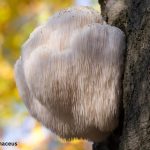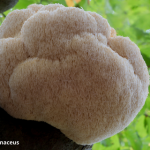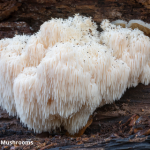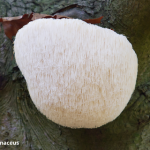If you like lion’s mane mushrooms, you might want to forage in your spare time. Foraging for mushrooms is not only good for your physical and mental health, but the activity can also be a great way to connect with nature.
However, some deceptive lion’s mane mushrooms could get in your way during your outdoor excursion.
Do not worry. This guide will tell you everything you need to know about these pesky lion’s mane mushrooms and how to identify lion’s mane mushrooms in the wild.
To meet Hericium Mushrooms: Discovering Lion’s Mane Doppelgangers

When you start learning about functional mushrooms, you’ll quickly realize that the lion’s mane mushroom is a member of the Hericiaceae family.
The official Latin name for the lion’s mane is Hericium erinaceus, but is also known as bearded tooth mushroom, monkey head mushroom or pom-pom mushroom. However, some other examples of Hericium species may resemble a lion’s mane. Let’s get to know the Hericium species better.
Hericiaceae Mushroom Family: A Quick Introduction
The Hericiaceae The mushroom family is categorized as white and fleshy mushrooms that grow on dead or dying trees. Hericium means hedgehog, as these mushrooms have a slightly spiky appearance. The spirals and details of these mushrooms are intricate and delicate. Some mushrooms in it Hericiaceae The family looks like snowflakes or icicles because of these tiny designs.
Lion’s mane is similar to the family Hericiaceae
Now you know what family is, let’s talk about it Hericiaceae mushrooms can be confused with lion’s mane mushrooms. Identifying lion’s mane mushroom requires knowledge of these other family members. All of these mushrooms are safe to eat, so when you go mushroom foraging, you won’t have to worry about getting poisoned!
Hericium americanum
Hericium americanum often confused with the lion’s mane (Hericium erinaceus) due to its similar appearance. However, Hericium americanum has long spines that are fully developed, while the lion’s mane mushroom will have shorter spines that are not fully developed.
Hericium coralloides
Hericium coralloides they are easier to distinguish from lion’s mane mushrooms. They have very short underdeveloped spines and smaller spores. This is the most distinct member of the Hericiaceae family.
Discover the best places to find lion’s mane mushrooms
To have a successful day picking wild mushrooms, you need to know where to look. This is where lion’s mane mushrooms grow:
- On hardwood trees – if you’re going to look for lion’s mane mushrooms, you’ll want to find forests in your area with lots of hardwood trees. Oak, Merbau, walnut, ash, beech, mahogany and maple are all considered hardwood species.
- On dead logs – You will need to search for dead logs and dead trees to find lion’s mane mushrooms.
- In North America – areas like Northern California are hotspots for finding lion’s mane mushroom. You can easily research the nearest foraging forests for lion’s mane with a quick Google search! There are even classes and guided trips to help you become more knowledgeable and skilled at foraging.
Note that in some countries, lion’s mane mushrooms are considered an endangered species. So you should check if it’s legal to forage for them before heading out into the wild to find them.
Tips for Locating Wild Lion’s Mane Mushrooms
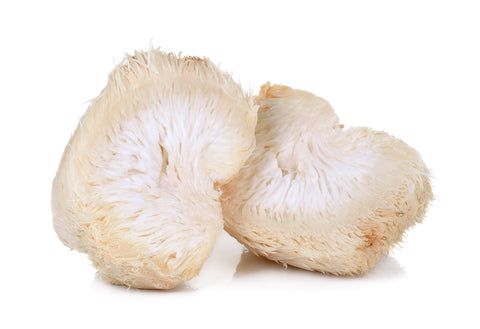
If you’re going to pick a wild edible mushroom, here are our top tips for spotting the wild lion’s mane.
Examine the color of the mushroom
It is important to check the color of the mushroom, as the Hericium The genus has a distinctive fresh cream or white color that is easy to spot in the wild. If you find a mature lion’s mane mushroom that is more yellow than cream, it is past its prime and should be left alone to decay and disperse its spores.
Maybe you can recognize this too Hericium genus by its characteristic smell. These important mushrooms have a lobster or crab flavor when eaten, and you’ll notice that slight seafood smell when foraging for lion’s mane. It’s very light, so if you’re not a fan of seafood, don’t be put off.
Be sure to verify the identity of the mushroom with guides or experts
Of course, many toxic mushrooms are out there in the woods, so before you cook and eat wild mushrooms, it’s important to check that you have the right mushroom. Fortunately, there are no poisonous mushrooms that can be mistaken for lion’s mane, but it’s always better to be sure.
5 Benefits of Lion’s Mane Mushrooms
If you still have to decide if it’s worth the trip to forage for a beard fungus, check out the awesome health benefits of the lion’s mane!
Supports memory, cognition and concentration
The lion’s mane mushroom contains erisenones and other cognitive-supporting compounds that encourage the body’s production of nerve growth factor (NGF), which can support neurological health. This mushroom is unsurpassed in its natural compounds that support our brain and cognitive function. Lion’s mane promotes mental clarity, focus and memory by providing nourishment to our neurons and brain system. It’s no wonder lion’s mane has become a popular nootropic. Lion’s mane mushrooms are like a cup of coffee, they keep you energized and focused during the work day.
Supports mood regulation
The lion’s mane mushroom has beneficial compounds called erisenones and others, which can support your body’s natural ability to fight occasional stress or bad mood. Lion’s mane supports the body’s natural processes to balance health in the hippocampus. By feeding and supporting this part of the brain, you can support stable moods and better withstand occasional feelings of stress or low mood.
Supports the body’s natural inflammatory response after training
As mentioned above, lion’s mane mushrooms are powerful allies in supporting the body’s ability to balance its response. By supporting your body in supporting your body’s natural occasional inflammatory activity after a workout or other similar activity, you can ensure that you feel rested and experience feelings of general well-being!
It supports the functions of the immune system
Lion’s mane mushrooms, and many other types of edible mushrooms, contain prebiotic compounds that can support gut health. Since the gut plays a vital role in immune function—handling all the bacteria that enters your body through the mouth, nose, and throat—lion’s mane can benefit your immune functions by supporting healthy gut flora. Think of a lion’s mane as your own personal immunity shield.
It helps your body go into a state of rest
The lion’s mane mushroom is known for its sleep-promoting powers. Lion’s Mane helps support sleep quality without making you drowsy.
Frequent questions
Still have some lingering questions about our friendly Hericium mushrooms? Here’s everything you need to know!
Is Hericium erinaceus Same as lion’s mane mushroom?
Yes! Hericium erinaceus it’s just the Latin or “scientific” name for the lion’s mane mushroom. The lion mushroom has many other names, including bearded tooth mushroom, pom-pom mushroom, and hedgehog mushroom.
Is there a fungus that looks like lion’s mane?
There are some fungi that resemble lion’s mane mushrooms, as they are all part of Hericium genus. Many species of this genus have a cream appearance and small complex spikes. The difference is determined by analyzing the length of the branches. None of the mushrooms in this genus are toxic.
Is lion’s mane mushroom psychoactive?
The lion’s mane mushroom is not the same as magic mushrooms, which contain psilocybin, known to cause psychoactive reactions and hallucinations. However, lion’s mane offers functional properties for your health and well-being – which we think is even cooler!
How much Lion’s Chow should I take regularly?
Because there are so many different formulations of lion’s mane supplements, it’s best to follow the directions on the package. To receive the health benefits of functional mushrooms, it is important to take them consistently.
We recommend downloading AdaptogenShrooms’s Lion’s Mane supplements! We use 100% certified organic mushroom fruiting body to ensure high quality supplements without fluff or filler.
What medications should I avoid while consuming lion’s mane?
Lion’s mane is not known to interact with prescription drugs. However, if you have questions, it is always wise to consult your doctor.
Which part of the lion’s mane is edible?
The entire fruiting body of the lion’s mane is edible. You can incorporate lion’s mane into your favorite seafood dishes to make them more vegan-friendly. The mushroom has a very light seafood flavor similar to crab, lobster or scallops and can easily replace these ingredients. Of course, the easiest and most convenient way to enjoy the health benefits of lion’s mane is to find high-quality supplements like those from AdaptogenShrooms!
Can I grow lion’s mane at home?
Although time-consuming, growing mushrooms at home can be an enjoyable and rewarding process. And, the good news is, you’ll only need a few tools to do it! If you’re up for the challenge, there are many resources available to help you grow your own lion’s mane mushrooms.
Take away
Foraging for mushrooms requires significant knowledge of mushroom identification so you don’t get poisoned! But the activity can be enjoyable, rewarding and therapeutic if you have a mushroom guide! The lion’s mane mushroom is easy to find and widely available in parts of North America – why not start your foraging journey soon?
You can also read our guide on identifying reishi and turkey tail mushrooms.
At AdaptogenShrooms, we love all things mushroom related. We are here to spread the word about the health benefits of mushrooms and offer the highest quality Lion’s Mane mushroom supplements available on the market. From Lion’s Mane in tinctures, powders, gum and capsules or mixed with 9 other powerful functional mushrooms in Daily Mix 10 products.
ABOUT THE AUTHOR
Mushy is your mentor in the enchanting world of adaptogenic mushrooms. An expert in mycology and holistic medicine, he fuses contemporary science with traditional wisdom to lift the veil on the benefits of mushrooms for health and well-being. With an informed, science-based approach, Mushy guides you through the mysterious world of mushrooms that strengthen the balance and resilience of body and mind. Whether you’re a curious neophyte or a seasoned explorer of medicinal mushrooms, Mushy is your ally in the quest for a more harmonious and energetic life.


